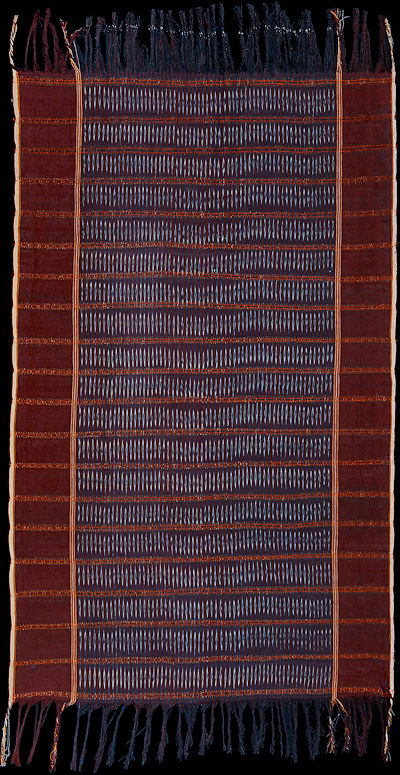| |
 
 | | | |
174 Sumatra, Batak
Uwi (shawl)  
| | Locale: | Si Tolu Huta area (probably), bordering Toba and Karo. | | Period: | 19th to early 20th c. | | Yarn: | Cotton, hand-spun, very fine | | Technique: | Warp ikat | | Panels: | 1 | | Size: | 95.5 x 149 cm (3' 1" x 4' 10") LW: 1.56 | | Weight: | 325 g (11.5 oz), 228 g/m2 (0.75 oz/ft2) | | Design: | Classic high class ulos in dark maroon with numerous narrow arrowheads in white on indigo arranged in nineteen bands. The bands are separated by jongkit duapuluh (Batak spelling, with final h), twenty stripes of supplementary weft in gold thread (gold wrapped around cotton core) running selvedge to selvedge. Solid solid maroon borders. Pinstripes in red, yellow, orange and white commercial yarn, most only two threads wide. Morinda weft. Casually twisted fringes.

Close-up showing irregularity of the very fine hand spun yarn. | | Comment: | Antique ulos of high ranking family in excellent condition. Cloth shows its age by minute fraying at the selvages. The yarn (except the few pinstripes mentioned above) is extremely fine hand spun cotton (see microscopic images), which stopped being made by the Batak around 1915. Cloth is very thin, and fairly losely woven (loser than otherwise comparable PC 253), giving it a delicate, gossamer-like aspect. This type of ulos might be presented by maternal grandparents on the birth of a daughter's first child, or by the father of a bride to wrap around the shoulders of the pair to promote fertility, and could also be worn by women as sarong or hood. Loosely twisted fringes appear to be characteristic for the type. The stripes with gold thread may represent rattan, the symbolic value of which is unclear. Ex collection Hans Groen. | | Background: | Chapters on Sumatra and Batak. | | Exhibited: | Hong Kong University Museum and Art Gallery, 2017. | | Published: | Ikat Textiles of the Indonesian Archipelago, 2018.
| | Compare: | 253 057 146 203 217 | | Sources: | Very similar to ulos sigaragara jongkit dua puluh in Sandra Niessen, Legacy in Cloth, p. 350. Very similar textile identified as ulos mangiring, but apparently with less clear definition, with eighteen bands rather than twenty, and without the gold thread, in Art Gallery of NSW, accession nr. 249.2000. Similar example with only nine ikated bands in Yale University Art Gallery (Holmgren and Spertus collection), ILE2006.4.111, that is merely identified as Batak and dated as 'ca. 1900'. Similar to pre-1884 example, apparently without gold thread, in Rotterdam Volkenkunde collection, No. 2742, which unfortunately was not photographed in its full length. It is depicted in Gittinger, Splendid Symbols, there identified as 'a textile of quiet dignity'. Near-identical to PC 253. Information on type and naming provided by Sandra Niessen.� | | |

©Peter ten Hoopen, 2025
All rights reserved.
|
|


